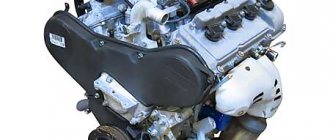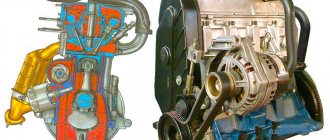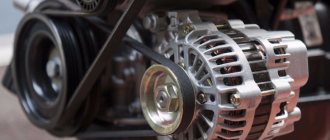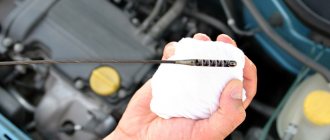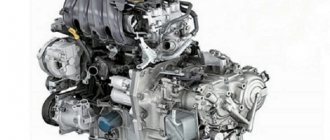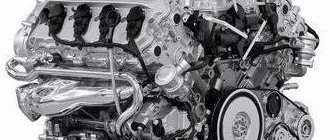The Mazda 1.6-liter engine is a purely Japanese power unit, which dates back to 1994. This engine belongs to the Z-series, represented by power units with a displacement of 1.3 to 1.6 liters and 16-valve cylinder heads. The first among them was a 1.5-liter engine for the Mazda 323.
A 1.6-liter engine under the catalog marking ZM appeared in 1998 on the Mazda 323. And for the Mazda 3 in 2003 it was seriously modified: the cast-iron cylinder block was replaced with an aluminum one, a plate chain appeared in the timing drive instead of a toothed belt, a phase shifter appeared and sophisticated intake manifold with flaps. This engine has the designation Z6 stamped on the block, and in catalogs it is designated as B6ZE. It was in production until 2013 and was used only on the Mazda 3.
By the way, because of this designation, this engine is classified as the old B-series. Indeed, the old cast iron B6 and aluminum Z6 have exactly the same cylinder diameter and piston stroke: 78 mm and 83.6 mm.
Let us add that together with the 1.6-liter engine, 1.3- and 1.5-liter engines (ZJ and ZY, respectively) were modernized in a similar way in 2002-2003.
On our YouTube channel you can watch disassembly of the Z6 / B6ZE engine (105 hp), taken from a 2004 Mazda 3 (BK). On the market this engine is known under the marketing designation 1.6 MZR.
You can select and buy an engine for Toyota in our catalog of contract engines.
Engine life Mazda 1.6 MZR
The Mazda 1.6 MZR engine is Japanese-style, reliable, unpretentious and durable. It can travel half a million kilometers and has no serious drawbacks.
You can choose and buy an engine for Mazda in our catalog of contract engines.
Right engine mount
The right engine mount on Mazda is hydraulic and not very durable. Its average service life is about 60,000 km. When it wears out and loses hydraulic fluid, vibrations spread throughout the body when the engine is running. Vibration can be felt both at idle and at high speed. And when changing gears, shocks may appear.
At the same time, the visually worn support looks quite alive, i.e. whole and undamaged.
Only the original support has a relatively long service life (its number is BEA2-39-060, for the 1.6 engine); it costs about $120.
Mazda 6 with engine 1.8 liters — brought for repairs from Kazan. The car owner complains about high oil consumption. Auto - 2011, one owner, dealer car. Current mileage 92 thousand km, the oil burn started with 70 thousand km. The car was serviced by an official dealer. The client looked at our article on repairing the Duratec 1.8 engine on a Ford C-Max and decided to entrust the repair of the Mazda engine to our hands. The fact is that the Mazda engine is the same Ford Duratek, only in a Mazda wrapper. It will be all the more interesting to compare these engines in different cars.The car smokes a lot, the engine needs to be disassembled. Let's get to work. First, we will conduct an external inspection. Under the cover with the Mazda badge hides an old acquaintance Duratek (the author still drives a C-Max and has already driven almost 100 thousand km since the engine was repaired). But Mazda thoroughly went over it in detail. The MAF (mass air flow sensor) is immediately visible - Ford does not have it, and the completely different arrangement of the mounted units is also noticeable. In Mazda, the generator is located at the back, next to the exhaust manifold, and the air conditioning compressor is located in front, on the engine, and not under the pan, like Ford). There is only one belt for the attachments and it is common. Engine mounts, valve covers, ignition coils and many other little things are also different. When the engine is running, a knocking sound is heard in the chain area.
The rear suspension is multi-link, very similar to Ford's, but everything has been changed a little - the shape and size of the arms, silent blocks. But the front suspension reminded me of Honda - wishbones, wheel drive passing through the strut. This is a higher class suspension than Ford's budget MacPherson strut.
We begin to disassemble the engine. The spark plugs are covered in black soot, the throttle inside is dirty with deposits from the EGR valve.
The client changed the bearing on the tension roller, and on one of the bypass masters in Kazan they tore off the edges of the bolt. In the photo below it is visible - next to the generator. Thanks to the Kazan craftsmen. I had to lower the engine, weld a nut to the bolt - after that I was able to unscrew it and remove the front engine cover.
A sad picture appeared before my eyes. The hydraulic chain tensioner is fully extended. There is no power reserve at all. The sprockets show heavy wear from the chain links. The shoes are also in need of replacement - there is some wear. The picture is similar for the small oil pump chain - the sprocket needs to be replaced, as does the tensioner shoe (it is tensioned by a spring). I was surprised that there was no damper shoe on the oil pump chain - Ford has one! Mazda installed such a suspension and saved a few bucks on a small part... At the same time, there is a place for a shoe, as well as two threaded holes on the crankshaft plate! The client present during the engine disassembly is surprised - the entire timing belt ( chain!!! ) needs to be replaced. On the mileage 92 thousand!!! Maybe the mileage has expired? No, the client assures that the mileage is real, the car has one owner.
It is more convenient to remove the head as an assembly with the exhaust manifold. On the casings, most of the bolts are stuck and are removed only after welding the large nut. Mazda with a 1.8 engine does not have a cathode collector, like Ford. We see something similar to a 4-2-1 exhaust manifold, with the two sections simply separated inside the pipe by a partition. Next comes the catalyst, but the client cut it out and replaced it with a flame arrester.
After removing the head, we see a funny picture in the cylinders - bald pots without honing. Attention is drawn to the hone spots scattered here and there on the mirror of the cylinders. Everything is clear - cast iron liners “breathe” in the block. This block is not cast under pressure (unlike the Koreans and Japanese), but simply into a mold. The adhesion of aluminum to the ribbed cast iron sleeve is poor, there are voids. It is useless to sharpen such a block to the repair size - the liner will become even thinner and oil consumption will be ensured immediately after repair. The thickness of the sleeve wall here is approximately 1.5 mm per side. Replacing the rings won't help either (as is the case with Ford). “Spotty” sleeves must be completely cut out of the block, new seats must be sharpened inside and the block must be sleeved with new thick-walled sleeves. Only in this case will this engine run without oil after repair. The hone spots are very clearly visible in the video (at the end of the report). Next, we dismantle the cylinder block for further disassembly. Please note that the flywheel here is single-mass and the clutch is equipped with a damper disc. We recommend replacing the clutch disc because... The linings are noticeably worn. The basket and flywheel will still serve. In Mazda, the distance between the side members is clearly smaller than in Ford, and problems arise when dismantling the block (we do not remove the box). We have to tinker.
The unit is dirty inside. Please note that the Duratek engine has piston oil cooling nozzles. We measure the geometry of the cylinders with a bore gauge. We measure the pistons with a micrometer and calculate the clearances. The cylinders have a cone shape (diameter difference up to 3 acres), the gap reaches 0.11 mm. The cylinders were simply swollen. We remove the antifreeze fitting (it interferes with the milling of the plane) and the centering bushings, and prepare the block for the sleeve.
The head is dirty with soot deposits from burned oil. We dismantle the valves and clean them of carbon deposits using an abrasive method. The client arrived with a burning “check” - the second lambda probe was completely clogged with soot, just like the snag. We clean everything and screw it into place. We change the bearings in the rollers. They are pressed out in a press and new bearings are installed in the same way. This is cheaper than changing the roller assembly. We wash the fuel injectors in an ultrasonic bath and check them on a bench. Mazda applied an original solution. There are nozzles in the sprayer instead of 4 holes, as many as 12 pieces. Presumably, the spray pattern of such nozzles is better (look at the photo), and the mixture formation is better. But they will clog noticeably faster on our “donkey urine fuel.”
In a couple of days we receive a set of new valve stem seals and begin assembling the head. The guide bushings here are in excellent condition and do not require repair. We have no complaints about the chamfers of the saddles. We wash the head, mill it and assemble it. By the way, the valve clearances here are within normal limits and do not require adjustment. We will not deal with the destruction of chamfers and the introduction of abrasives into them (by grinding in the valves), because We have no complaints about the chamfers and their tightness. Let's leave this activity to people who are accustomed to repairing ZILs in the field.
We disassemble and repair the oil pump. When repairing the S-Max, the author blurted out that there was no mesh in the oil receiver. Attentive people did not fail to reproach the author in the comments on YouTube. And they are right. In fact, there is a mesh and it is soldered inside the plastic oil receiver. This is clearly visible in the second photo. The pump itself is in good condition and does not require replacement. We wash it and put it back together, not forgetting to lubricate it with oil.
We didn't keep the old pistons. The layer of anti-friction coating on the skirts had already been erased, and on one of the pistons the process of lifting the skirt had begun. We unpress the connecting rods (the seat of the finger in the connecting rod is “hot”). I was surprised that the piston pins showed no noticeable wear. Perhaps the lubrication of the fingers is better organized here (due to oil nozzles). We measured the length of the connecting rod - 146.2 mm . With a crankshaft stroke of 83.1 mm , we get an RS-ratio of 1.759. A set of Chinese Autovelt pistons cost just under 10 thousand rubles. Aesthetes can order the original Kolbenschmidt at a price 2.5 times higher, but in our regions the income is not so great and we are forced to save the client’s money. The pistons look normal, with the same coating as the original. In the grooves of the 3rd ring we drill several holes for oil supply. They are not included in the piston design and this is a disadvantage of this engine.
The old thin sleeves were completely cut out of the block, and seats were cut out of the aluminum. New thick-walled liners with an upper thrust collar were made and pressed into the block. The mating plane is milled. The cylinders are bored and honed to fit new standard pistons with a diameter of 83 mm . Gap 0.03 mm. With such thick liners, you can safely blow into the block with a turbine...
We assemble connecting rods with new pistons. We update the bearings (the main bearings are non-original, the connecting rod bearings are original Mazda). Piston rings - Autovelt, set. The rear oil seal is plastic, it is almost eternal, there were no leaks from it. We leave it as is (it covered several hundred thousand km on the Ford S-Max), but we put the bolts on Loctite. We update the clutch disc (non-original) - its linings are noticeably thicker and install a new Mazda release bearing (the old one has dried out).
On the exhaust manifold flange we update the graphite ring and studs. We install a new oil seal in the front cover. Here, Mazda also saved money and installed a rubber seal instead of a plastic one, like Ford’s. Installing the block in the engine compartment is a real pain. The block is large, the compartment is narrow. Guess how they installed it. The subframe was not disassembled, the box was not removed. After inserting the block, installing the head is a breeze.
I can rightfully say that the Duratek motor was designed by fools . Sleeves that breathe in the block and swell during use, a timing chain drive with bicycle chains that don’t run for a long time and other wonders in the country of Duracovalandia. If you buy the entire timing chain kit (large chain, tensioner, two shoes, 3 sprockets, small chain, oil pump sprocket, tensioner and stabilizer shoes), the price tag is about 30 thousand rubles for original spare parts. And these spare parts have covered only 92 thousand km ! With this money you can buy 6-8 sets of Gates belts and rollers on a Priora and drive them for 300-480 thousand km (with a replacement interval of 60 tkm). Great arithmetic, isn't it? But in our regions we don’t have the income to spend so much money on timing belts. Non-original spare parts help out. We order a large timing kit of the BGA . The price tag is about 9 thousand rubles . It includes a large chain, tensioner, two shoes, 3 sprockets and hardware. Additionally, we buy a small oil pump chain, an oil pump sprocket, small tensioner and damper shoes. This is all original , we take Ford or Mazda article numbers, whichever is cheaper. You have to work with two directories at once. Unfortunately, there are no non-originals. For this we pay about 7 thousand rubles more. BGA main circuit kit looks good. Supposedly made in the UK. I believe - Asian copies of original parts. After installing the BGA kit, the new hydraulic tensioner extended approximately 25-30% of its travel . BGA chain - the transverse play in the links is too large, but the longitudinal play on the links is much less than the play felt on the original chain. The main sprocket does not have grinding of the thrust surfaces under the lock washers, unlike the original. And yes, we installed a damper shoe on the small oil pump chain, as Ford does. To do this, the turner had to order two centering bushings for the shoe mounting bolts. The entire set of chains, shoes and sprockets cost 17 thousand rubles . Thanks to the BGA kit, you saved a lot on the cost of spare parts, but did you lose in service life? As you can see, a modern chain drive has no advantages in terms of service life and price over a belt drive. This is also confirmed by sellers of spare parts in private conversations (belt drive is cheaper to operate). I'm sorry, what? Reliability you say? And you know, a Duratek chain can suddenly break (you can easily find cases in search engines) with subsequent bending of the valves - that’s for sure, the motor is from Duracovalia.
We install new spark plugs, oil and air filters, fill in new oil for break-in. We finally assemble the motor. We wash the intake throttle clean.
The engine starts, runs smoothly, the check engine light is off. The smoke also disappeared. And what’s important is that the chain noise is gone! You can only hear the clatter of the injectors.
Let's summarize the financial results. 48 thousand rubles for spare parts , another 15 thousand rubles for machining the block with the manufacture of liners, and 29.5 thousand rubles for our work on the engine, cleaning valves and repairing the head, washing and milling the head, washing fuel injectors, minor repairs ( replacing roller bearings, cleaning the lambda). Total 93 thousand rubles - major repairs of the Mazda 6 .
We repaired the engine in just 1 week . This includes disassembly, waiting for custom parts, lining the block and assembling the motor.
I invite the reader to watch videos filmed during the repair of the Mazda 6 (L813) - there you can see nuances not discussed in the text of the article.
Article written: May 29, 2020 Author of the article, photo-video materials: © Quasar Prohibited without the written permission of the author: reprinting the article in whole or in part, reprinting and using photo-video materials, as well as changing and editing them for the purpose of further publication on third parties websites.
Throttle valve
The throttle valve on the Mazda 1.6 MZR engine usually does not cause any trouble. There are rare cases of air leaking through its gasket, which is why the idle speed floats or becomes elevated.
This throttle valve is equipped with antifreeze heating - a tube is laid to it. In rare cases, antifreeze may leak through a channel in the damper body. In this case, you will either have to buy a used damper or patch the crack. In warm climates, you can simply plug the antifreeze channel in the throttle and connect the tube through an adapter at its break.
You can select and buy a throttle valve for a Mazda engine in our catalog of contract spare parts.
Intake manifold
The intake manifold of the Mazda 1.6 MZR engine is equipped with a mechanism for changing its length and turbulence flaps. The damper, which “switches” the length of the intake channels, is controlled by an electric motor. This entire design is reliable, and the only problem associated with it can be easily eliminated with improvised means.
Over time, when the engine is running, the intake manifold begins to knock or chirp - this is where the axis of the length change flap is knocking. Those. it slightly breaks up the seats in the plastic, which causes axial play.
The backlash must be eliminated. This is done simply: they place plastic or rubber washers under the axle gear or add a suitable spring on the side of the electric motor. This way the backlash is removed and the damper stops chirping.
You can select and buy an intake manifold for a Mazda engine in our catalog of contract spare parts.
Malfunctions and diagnostics of Mazda 3 Z6 1.6 engines
One of the most popular engines in Europe for the third series model, which became a logical continuation of the design of the B6D engine. This engine performed well, but in the Z6 version it received a number of improvements. They may be considered controversial here, but useful in the EU. This is due to fuel quality, since the EGR system was integrated into the engine design. Its ultimate goal was to reduce the level of exhaust toxicity. The operation of the system is that it drives exhaust gases through the combustion chamber a second time for complete afterburning. Such things happen with EU fuel. With ours - not always. Moreover, the system does not in any way affect the engine’s power performance or its efficiency, but can lead to the deposition of excess waste both in the system valve itself and in the combustion chamber. Over time, the EGR valve becomes covered with carbon deposits, begins to close loosely, and over time even freezes. This leads to a rapid drop in power, increased fuel consumption, and the engine can easily stall out of the blue without declaring war. Of course, they found a solution, but the residue remained - the owners simply turned off the EGR valve, which also eliminated the problems with idle.
Another unpleasant feature of this engine is the lack of hydraulic valve compensators. This forces every 120 thousand to carry out labor-intensive adjustment of the thermal gap by selecting glasses.
The Mazda 3 Z6 1.6 engine became a logical continuation of the design of the B6D engine
The main problems that were identified in the Z6 engine through diagnostics can be identified:
- Floating idle speed. The real scourge of all diagnosticians. No amount of adjustment could reveal the true cause of the unstable speed. The problem was solved quite simply - as soon as the intake manifold gasket was changed, the idle speed stabilized. Diagnostic equipment did not detect the rapidly changing percentage composition of the working mixture.
- The Z6 engine could vibrate quite a bit at idle and in transition. The problem lies in the engine mount. Its service life, as it turned out, is lower than the overhaul service life, so by replacing the engine support cushion, the problem can be solved.
- Knocking in a Z6 engine is uncommon, but the right diagnostic equipment and an experienced technician can help. The knocking usually comes from the connecting rod bearings if the engine has been running more than 200 thousand on our oil. A knock at the top will indicate incorrect valve clearance or a stretched timing chain. But before 150 thousand, knocking rarely appears, and only in cases where the engine often runs “at the cut-off point”.
- Diesel taste in the sound of the engine, bubbling. This is the same mechanism of the EGR exhaust gas recirculation system. As a result of wear and coking, the intake manifold can become overgrown with soot, which is practically useless to combat. It is better to immediately replace the entire collector. The engine will work completely differently.
Knock sensor
Often the knock sensor on the Mazda 1.6 MZR engine fails. This does not affect the operation of the engine in any way, only the corresponding error appears (P0328). The sensor must be replaced; it is undesirable to operate the engine when it is faulty, because You can get into trouble with the destruction of the piston group if the ECU is unable to detect real detonation and combat it.
Injectors
The fuel injectors of the Mazda 1.6 MZR engine are quite durable, but can cause misfire in one or more cylinders. When a misfire occurs, the corresponding error is recorded (P0300, P0301…P0304). Of course, before replacing or cleaning the injectors, owners have time to install new spark plugs and “juggle” the ignition coils. If the misfire error does not move to another cylinder, then it’s time to work on the injectors.
You can select and buy gasoline injectors and a fuel rail for a Mazda engine in our catalog of contract spare parts.
Adjustment of valves
According to the old Japanese tradition, the Mazda 1.6 MZR engine is not equipped with hydraulic compensators. The valves are adjusted in the most inconvenient way: by selecting pusher cups. To do this, you need to remove the timing chain and raise the camshafts.
In practice, this engine does not require valve adjustment for 200,000 km. But this is in the case of operation on gasoline. But when operating on gas, the thermal clearances of the exhaust valves “go away” every 60,000 - 80,000 km.
Those. The exhaust valve seats wear out, causing the clearances to decrease and the valves to be pressed against the exhaust camshaft cams. In this case, the exhaust valves remain open for a longer period of time and may not adhere well to the seats, which reduces compression in the cylinders and misfires occur. Those. The engine is unstable, jerks and does not produce full power. In the future, the exhaust valves overheat and burn out locally.
Specifications
Characteristics of the Mazda Skyactiv 2.5 liter engine
| OPTIONS | MEANING |
| Years of manufacture | 2011-present |
| Configuration | L |
| Cylinder block material | aluminum |
| Supply system | injector, direct fuel injection with electric. management |
| Type | in-line |
| Working volume, l | 2.5 |
| Power, l. With. | 192 |
| Number of cylinders | 4 |
| Number of valves per cylinder | 4 |
| Cylinder operating order | 1-3-4-2 |
| Gas distribution mechanism | DOHC |
| Piston stroke, mm | 100 |
| Cylinder diameter, mm | 89 |
| Compression ratio | 14 |
| Max torque, Nm | 256 at 3250 rpm |
| Environmental standards | Euro 5 |
| Fuel | 95 petrol |
| Fuel consumption, l/100 km | Mixed 6.3 |
| Oil | 0W-20 |
| Oil consumption, g/1000 km | 800 |
| How much oil is in the engine, l | 4.5 |
| When replacing, pour, l | 4 |
| Oil change carried out, km | 15000 |
| Engine life, thousand km | |
| - according to the plant | 250 |
| - on practice | More than 300 |
The motor is installed on the Mazda CX-5, Mazda 6 and Mazda 3.
Phase shifter
The Mazda 1.6 MZR engine is equipped with a phase shifter mounted on the intake camshaft. Believe it or not, this phase shifter does not cause any complaints at all. There are practically no complaints about him. Although it is fundamentally designed like most hydraulic phase shifters.
You can select and buy a phase shifter (phase regulator) for a Mazda engine in our catalog of contract spare parts.
Most popular units
Some gasoline engines that were installed on various generations of Mazda 6 models have become more popular than other powertrains. For example, the MZR L813 engine, which can be seen in both the first and second generations, as well as in additional restyling.
A little about the technical characteristics of the MZR L813. Its exact displacement was 1798 cm3, and its maximum power was within 120 hp. 4 cylinders arranged in one row, 16 valves. Fuel consumption in the city is no more than 8.3 - 8.5 liters, on the highway - 6.9 - 7.0 liters. The most acceptable unit with fairly economical fuel consumption, provided that its octane number is at least 95.
Also, from the first generation, the Mazda 6 model was equipped with an MZR LF17 gasoline engine, with a displacement increased to two liters (more precisely - 1999). With such characteristics, its consumption has become even less than that of the MZR L813 unit (in the city - 8.8 liters, on the highway - 6.6 liters). The same number and arrangement of cylinders and valves. For maximum productivity, you must use fuel with an octane rating of at least 95.
Cylinder block
Let us note once again that the cylinder block of the Z6 engine is aluminum, with an open cooling jacket and cast iron liners. As a rule, nothing bad happens to the block. But there were cases when, due to the destruction of the catalyst, ceramic dust penetrated into the cylinders, which led to scuffing on the cylinder surface.
Ceramic dust enters the cylinders during internal exhaust gas recirculation. Gases with ceramic particles are easily sucked into the cylinders, because in the exhaust manifold the pressure is higher (closer to atmospheric or even higher if the catalyst is destroyed and clogged), and in the “aspirated” intake manifold there is a vacuum. Thus, during internal recirculation, ceramic dust enters the cylinders.
You can select and buy a cylinder block for a Mazda engine in our catalog of contract spare parts.
Mazda 6 / Mazda 6
History of changes
For the Mazda 6 gg, the technical specifications changed with each new restyling.
The first generation of the car appeared in the 2003 Mazda 6. The design, interior, platform, optics have changed. The wheel arches have been widened. The appearance has become more prominent and sporty. Three body styles were offered. For this brand, these are the standard sedan, hatchback, and sports station wagon. Interior trim: leather, plastic, light alloys. Cruise control on the steering wheel. Adjustable seat to sports seat position.
Wide selection of engines for any body. Gearbox optional: manual or automatic. A double-wishbone suspension was installed at the front and a multi-link at the rear. A distinctive feature was the extremely rigid design, which significantly increased the level of safety.
The end of 2005 marked the appearance of the new Mazda 6 2.3 MPS Turbo model. It was a sports sedan model. It had an all-wheel drive transmission, sports suspension and interior trim. Volumetric, comfortable, with a strong turbocharged engine.
The second generation was presented by the Mazda 6 gg 2007 model. Three previous body options were preserved. But the dimensions have increased significantly. The interior has changed slightly, becoming calmer and more respectable. An engine with a volume of 2.5 liters and 170 hp, working only with mechanics, was added to the main line of engines. At the same time, the efficiency of the power unit has increased significantly. The chassis has changed noticeably. There was an independent suspension and electric power steering. The developers managed to cope with noise insulation problems. The level of security has increased even more.
The next restyling was carried out in 2010. A car with further innovations in technical characteristics was presented in Geneva. The engine and chassis, as well as the gearbox, were completely changed. At the same time, the appearance and interior have changed slightly. 2.5 liter engine. I started working not only with manuals, but also with automatics. Sound insulation has become even better.
The third generation of the car appeared in 2013. The legendary SkyActiv technology was used, thanks to which the weight of the machine was reduced by 100 kg, and torsional rigidity increased by 30%. Two four-cylinder engines SKYACTIV-G 2.0 and SKYACTIV-G 2.5 with 150 and 192 hp came to the Russian market. respectively.
Security measures have been achieved to the maximum. There is now control of “dead spots” and the ability to stop without driver control over the process.
Rotating the liners
A common but known problem with the Mazda 1.6 MZR engine is the turning of the connecting rod bearings. Typically, the engine begins to knock loudly due to the rotation of one or more bearings that are located further from the oil pump. Those. This is the 4th or 3rd liner. If the owner pays attention to the extraneous knock in time, he will be able to get by by replacing all the connecting rod bearings. Those. the crankshaft connecting rod journals will not be damaged.
This problem occurs due to low-quality oil. Although it doesn't hurt to check the actual oil pressure. But usually there are no questions about the oil pump: it continues to create sufficient oil pressure and the pressure relief valve works normally.
You can select and buy an engine for Mazda RAV4, Mazda Avensis in our catalog of contract engines.
Here you can use the links to see the availability of specific Mazda vehicles at the dismantling site and order auto parts from them.
Recommendations for caring for the motor
According to the manufacturer, Mazda 6 gasoline internal combustion engines must operate properly with a mileage of over 300,000 km. In reality, with high-quality implementation of routine maintenance and official recommendations, engines can cover another 150-200 thousand km.
The gas distribution mechanism with four valves per cylinder and a chain drive requires attention with a mileage of about one hundred thousand kilometers. On engines without hydraulic valve compensators, it is necessary to adjust the gaps every 140-150 thousand km.
Increased oil consumption is observed only with an aggressive driving style. There are no leaks, even in cars with high mileage. The main maintenance recommendation is to regularly change the engine oil in accordance with the manufacturer's recommendations. Only high-quality low-viscosity synthetic oil can be used.
Mazda 6 diesel engines are also considered reliable, with proper treatment and maintenance. To avoid costly repairs, use high-quality lubricants when replacing.
Unfortunately, diesel engines for Mazda 6 are no longer officially offered on our market; such cars are sold from third parties and countries, so it is often impossible to check their service history.
